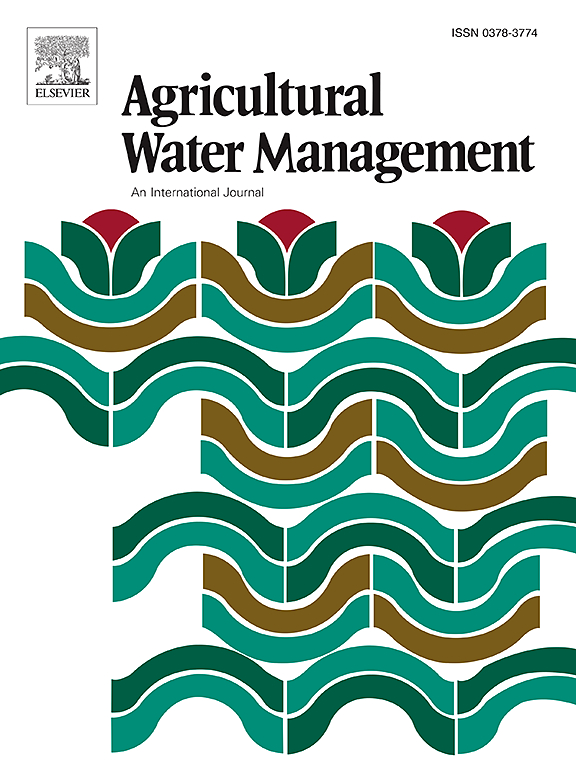干旱时根区土壤湿度表现的因果推断
IF 5.9
1区 农林科学
Q1 AGRONOMY
引用次数: 0
摘要
土壤水分在地表水文过程和陆地-大气相互作用中起着至关重要的作用。它可以直接影响植被生长,是监测农业干旱的重要指标。然而,根区土壤水分的空间连续数据集依赖于模型模拟,带来了与模型参数和输入数据相关的诸多不确定性。目前,已有多种由模型模拟得出的土壤水分产品,但它们在空间尺度上的代表性仍不明确。此外,它们在土地-大气耦合中表达土壤-大气和土壤-植被相互作用的能力也不清楚,这导致了对干旱的不同倾向。本研究调查了欧洲中期天气预报中心再分析第五版陆地(ERA5-Land)、全球陆地数据同化系统(GLDAS)、全球陆地蒸发阿姆斯特丹模式(GLEAM)、现代研究和应用回顾分析第二版(MERRA-2)和 SoMo.ml 这五种土壤水分产品在干旱条件下的表现。计算了这些产品与国际土壤水分网络站点观测数据之间的偏差、相关性和标准偏差(STDD)。使用因果效应彼得和克拉克(PC)矩条件独立性(MCI)方法计算了土壤、气象和农业干旱的因果概率,以评估这些产品的数据倾向性。ERA5-Land和SoMo.ml具有相似的性能,准确度最高,这归因于使用了相同的气象强迫数据。这两种产品在表层、中层和深层的土壤水分与观测站观测数据的偏差均低于 0.1 立方米/立方米,STDD 的偏差在 0.05 立方米/立方米以内。GLDAS 的精度相对较低,其特点是相关性较低(深层低于 0.2),偏差较大(中层和深层分别高于 0.15 和 0.2)。这种差异可能是由于降水强迫数据的严重偏差造成的。ERA5-Land显示了更高的空间分辨率和更大的空间异质性,而MERRA-2在这方面表现不佳。MERRA-2 与农业干旱的关系最为密切,其倾向概率为 0.477。相反,SoMo.ml 与气象干旱的关联性最强,倾向概率为 0.234。由于 MERRA 数据同化过程中模拟数据和观测数据存在误差、土壤水分数据存在较大偏差以及 GLDAS 的气象强迫精度较低,这两种产品之间的土壤水分干旱与气象干旱之间没有明显的因果关系。这些发现为在干旱研究中使用土壤水分产品提供了建议。本文章由计算机程序翻译,如有差异,请以英文原文为准。
Causal inference of root zone soil moisture performance in drought
Soil moisture plays a crucial role in surface hydrological processes and land–atmosphere interactions. It can influence vegetation growth directly, serving as a significant indicator for monitoring agricultural drought. However, spatially continuous datasets of root zone soil moisture rely on model simulations, introducing numerous uncertainties associated with model parameters and input data. Currently, multiple soil moisture products derived from model simulations exist, but their representation at spatial scales remains unclear. Moreover, their abilities to express soil–atmosphere and soil–vegetation interactions within land–atmosphere coupling are not understood, leading to divergent inclinations toward drought. This study investigates the performance of five soil moisture products, European Centre for Medium-Range Weather Forecasts Reanalysis v5-Land (ERA5-Land), Global Land Data Assimilation System (GLDAS), Global Land Evaporation Amsterdam Model (GLEAM), The Modern-Era Retrospective analysis for Research and Applications, Version 2 (MERRA-2), and SoMo.ml, under drought conditions. The bias, correlation, and difference of standard deviation (STDD) were calculated between these products and the observations from International Soil Moisture Network stations. The causal probability of soil, meteorological, and agricultural drought was calculated using the causal-effect Peter and Clark (PC) Momentary Conditional Independence (MCI) method to evaluate the data propensity of these products. ERA5-Land and SoMo.ml gave a similar performance with the highest accuracy, which was attributed to the use of the same meteorological forcing data. The biases of soil moisture from these two products at surface, middle and deep depths against station observations are below 0.1 m3/m3, and the STDD is within 0.05 m3/m3. The accuracy of GLDAS is comparatively lower, characterized by lower correlations (below 0.2 for deeper layers) and high bias (above 0.15 and 0.2 for middle and deep layers, respectively). This discrepancy could be attributed to substantial biases in the precipitation forcing data. ERA5-Land shows higher spatial resolution and greater spatial heterogeneity, whereas MERRA-2 underperformed in this area. MERRA-2 had the strongest connection to agricultural drought, with a propensity probability of 0.477. Conversely, SoMo.ml demonstrates the strongest connection to meteorological drought, with a propensity probability of 0.234. Due to the errors in simulated and observational data during the MERRA data assimilation, substantial biases in the soil moisture data, and low accuracy in meteorological forcing of GLDAS, there was no clear causal relationship between soil moisture drought and meteorological drought between these two products. These findings provide recommendations for the use of soil moisture products in drought research.
求助全文
通过发布文献求助,成功后即可免费获取论文全文。
去求助
来源期刊

Agricultural Water Management
农林科学-农艺学
CiteScore
12.10
自引率
14.90%
发文量
648
审稿时长
4.9 months
期刊介绍:
Agricultural Water Management publishes papers of international significance relating to the science, economics, and policy of agricultural water management. In all cases, manuscripts must address implications and provide insight regarding agricultural water management.
 求助内容:
求助内容: 应助结果提醒方式:
应助结果提醒方式:


